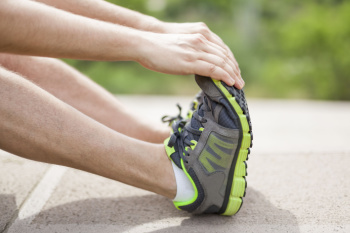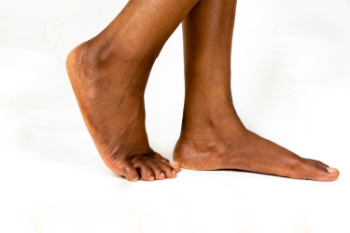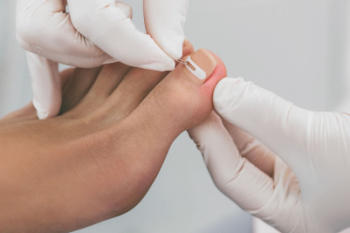Connect With Us
Blog
Items filtered by date: February 2024
Causes of Night Foot Pain

Every day, foot pain affects millions of people worldwide, ranging from dull aches to sharp stings. Some experience foot pain solely at night, disrupting their sleep quality. One common cause is plantar fasciitis, where the tissue running from the foot's front through the arch to the heel becomes inflamed, often worsened by factors like flat feet or tight calf muscles. Another foot pain culprit is Morton’s neuroma, which is characterized by pinching or inflammation around the nerves in your toes and can lead to burning or shooting pains. Pregnancy-related changes in calcium levels may cause leg and foot cramps. Diabetes can damage foot nerves due to high blood sugar levels. Fibromyalgia sufferers often experience widespread pain, including in the feet, exacerbated at night by low cortisol levels. Lifestyle factors and foot anatomy also contribute to nighttime foot pain. If you are experiencing persistent nighttime foot pain, it is suggested that you make an appointment with a podiatrist for a proper diagnosis and appropriate treatment.
Foot Pain
Foot pain can be extremely painful and debilitating. If you have a foot pain, consult with one of our podiatrists from Bangor Podiatry. Our doctors will assess your condition and provide you with quality foot and ankle treatment.
Causes
Foot pain is a very broad condition that could be caused by one or more ailments. The most common include:
- Bunions
- Hammertoes
- Plantar Fasciitis
- Bone Spurs
- Corns
- Tarsal Tunnel Syndrome
- Ingrown Toenails
- Arthritis (such as Gout, Rheumatoid, and Osteoarthritis)
- Flat Feet
- Injury (from stress fractures, broken toe, foot, ankle, Achilles tendon ruptures, and sprains)
- And more
Diagnosis
To figure out the cause of foot pain, podiatrists utilize several different methods. This can range from simple visual inspections and sensation tests to X-rays and MRI scans. Prior medical history, family medical history, and any recent physical traumatic events will all be taken into consideration for a proper diagnosis.
Treatment
Treatment depends upon the cause of the foot pain. Whether it is resting, staying off the foot, or having surgery; podiatrists have a number of treatment options available for foot pain.
If you have any questions, please feel free to contact our offices located in Bangor, Gilbert, and Bethlehem, PA . We offer the newest diagnostic and treatment technologies for all your foot care needs.
Stretches for Healthy and Strong Feet

Maintaining healthy and strong feet is essential for overall well-being and mobility. Incorporating regular stretching exercises into your routine can help improve flexibility, reduce stiffness, and prevent common foot issues. Toe stretches, such as toe flexion and extension, help stretch the muscles and ligaments in the toes, promoting better mobility and preventing conditions like plantar fasciitis. Calf stretches, like the calf raise and wall stretch, target the Achilles tendon and calf muscles, reducing tightness and improving range of motion in the ankles and feet. Arch stretches, such as the towel stretch and golf ball roll, can alleviate discomfort and strengthen the arches of the feet, reducing the risk of conditions like flat feet. Additionally, performing ankle circles and ankle alphabet exercises can help improve ankle stability and mobility, enhancing overall foot function. If you would like information about additional specific foot stretches to practice for healthy, strong feet, it is suggested that you schedule an appointment with a podiatrist.
Exercising your feet regularly with the proper foot wear is a great way to prevent injuries and build strength. If you have any concerns about your feet, contact one of our podiatrists from Bangor Podiatry. Our doctors can provide the care you need to keep you pain-free and on your feet.
Exercise for Your Feet
Exercise for your feet can help you gain strength, mobility and flexibility in your feet. They say that strengthening your feet can be just as rewarding as strengthening another part of the body. Your feet are very important, and we often forget about them in our daily tasks. But it is because of our feet that are we able to get going and do what we need to. For those of us fortunate enough to not have any foot problems, it is an important gesture to take care of them to ensure good health in the long run.
Some foot health exercises can include ankle pumps, tip-toeing, toe rises, lifting off the floor doing reps and sets, and flexing the toes. It is best to speak with Our doctors to determine an appropriate regimen for your needs. Everyone’s needs and bodies are different, and the activities required to maintain strength in the feet vary from individual to individual.
Once you get into a routine of doing regular exercise, you may notice a difference in your feet and how strong they may become.
If you have any questions please feel free to contact our offices located in Bangor, Gilbert, and Bethlehem, PA . We offer the newest diagnostic and treatment technologies for all your foot and ankle needs.
Is My Foot Pain Caused by Flat Feet?
 Flatfoot occurs when the arches of the feet are low or even touch the ground. While many people with flatfoot don’t experience major foot problems, the altered biomechanics of the foot can lead to foot pain and gait issues. Collapsed arches can strain the ligaments, tendons, and muscles that support the foot's structure. This strain is what may lead to pain, particularly in the arch area and the inner side of the ankle. This pain can even extend to the knee or lower back. Individuals with flat feet may experience pain during prolonged periods of standing or walking. The absence of a natural arch can also affect shock absorption, increasing the force on joints and potentially causing discomfort. Podiatrists can recommend supportive footwear, shoe inserts, and targeted exercises to strengthen the foot muscles. If you have foot pain and flat feet, it is suggested you consult with a podiatrist who can locate the source of your pain and provide a customized treatment plan to improve your foot health.
Flatfoot occurs when the arches of the feet are low or even touch the ground. While many people with flatfoot don’t experience major foot problems, the altered biomechanics of the foot can lead to foot pain and gait issues. Collapsed arches can strain the ligaments, tendons, and muscles that support the foot's structure. This strain is what may lead to pain, particularly in the arch area and the inner side of the ankle. This pain can even extend to the knee or lower back. Individuals with flat feet may experience pain during prolonged periods of standing or walking. The absence of a natural arch can also affect shock absorption, increasing the force on joints and potentially causing discomfort. Podiatrists can recommend supportive footwear, shoe inserts, and targeted exercises to strengthen the foot muscles. If you have foot pain and flat feet, it is suggested you consult with a podiatrist who can locate the source of your pain and provide a customized treatment plan to improve your foot health.
Flatfoot is a condition many people suffer from. If you have flat feet, contact one of our podiatrists from Bangor Podiatry. Our doctors will treat your foot and ankle needs.
What Are Flat Feet?
Flatfoot is a condition in which the arch of the foot is depressed and the sole of the foot is almost completely in contact with the ground. About 20-30% of the population generally has flat feet because their arches never formed during growth.
Conditions & Problems:
Having flat feet makes it difficult to run or walk because of the stress placed on the ankles.
Alignment – The general alignment of your legs can be disrupted, because the ankles move inward which can cause major discomfort.
Knees – If you have complications with your knees, flat feet can be a contributor to arthritis in that area.
Symptoms
- Pain around the heel or arch area
- Trouble standing on the tip toe
- Swelling around the inside of the ankle
- Flat look to one or both feet
- Having your shoes feel uneven when worn
Treatment
If you are experiencing pain and stress on the foot you may weaken the posterior tibial tendon, which runs around the inside of the ankle.
If you have any questions please feel free to contact our offices located in Bangor, Gilbert, and Bethlehem, PA . We offer the newest diagnostic and treatment technologies for all your foot and ankle needs.
Keep Your Feet Healthy So You Can Stay Active
Definition of Partial and Total Nail Avulsion

When grappling with the discomfort of ingrown toenails, partial and total nail avulsion emerges as a viable solution. Partial nail avulsion involves the removal of a portion of the affected nail, addressing the ingrown edge, and providing relief. This procedure aims to eliminate the problematic segment while preserving the overall integrity of the nail. Conversely, total nail avulsion involves completely removing the toenail, offering a more comprehensive approach to severe or recurrent ingrown toenails. Both procedures are typically performed under local anesthesia to minimize discomfort. Proper postoperative care is vital to promote healing and prevent complications following avulsion. Understanding the differences between partial and total nail avulsion allows individuals to make informed decisions in collaboration with podiatrists. If you have developed an ingrown toenail, it is strongly suggested that you are under the care of a podiatrist who can determine if one of these types of surgery is right for you.
Ingrown toenails may initially present themselves as a minor discomfort, but they may progress into an infection in the skin without proper treatment. For more information about ingrown toenails, contact one of our podiatrists of Bangor Podiatry. Our doctors can provide the care you need to keep you pain-free and on your feet.
Ingrown Toenails
Ingrown toenails are caused when the corner or side of a toenail grows into the soft flesh surrounding it. They often result in redness, swelling, pain, and in some cases, infection. This condition typically affects the big toe and may recur if it is not treated properly.
Causes
- Improper toenail trimming
- Genetics
- Improper shoe fitting
- Injury from pedicures or nail picking
- Abnormal gait
- Poor hygiene
You are more likely to develop an ingrown toenail if you are obese, have diabetes, arthritis, or have any fungal infection in your nails. Additionally, people who have foot or toe deformities are at a higher risk of developing an ingrown toenail.
Symptoms
Some symptoms of ingrown toenails are redness, swelling, and pain. In rare cases, there may be a yellowish drainage coming from the nail.
Treatment
Ignoring an ingrown toenail can have serious complications. Infections of the nail border can progress to a deeper soft-tissue infection, which can then turn into a bone infection. You should always speak with your podiatrist if you suspect you have an ingrown toenail, especially if you have diabetes or poor circulation.
If you have any questions, please feel free to contact our offices located in Bangor, Gilbert, and Bethlehem, PA . We offer the newest diagnostic and treatment technologies for all your foot care needs.
Blog Archives
- August 2025
- July 2025
- June 2025
- May 2025
- April 2025
- March 2025
- February 2025
- January 2025
- December 2024
- November 2024
- October 2024
- September 2024
- August 2024
- July 2024
- June 2024
- May 2024
- April 2024
- March 2024
- February 2024
- January 2024
- December 2023
- November 2023
- October 2023
- September 2023
- August 2023
- July 2023
- June 2023
- May 2023
- April 2023
- March 2023
- February 2023
- January 2023

